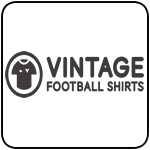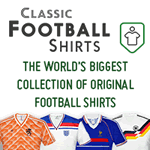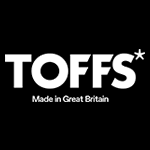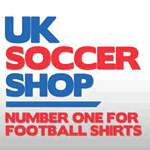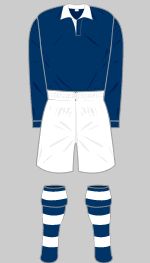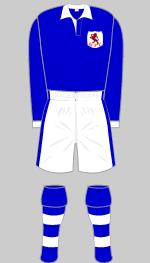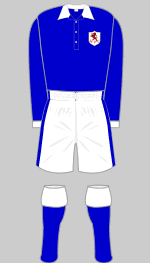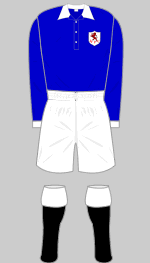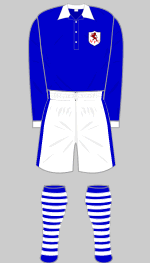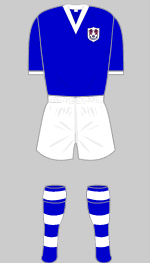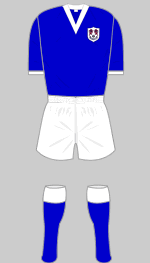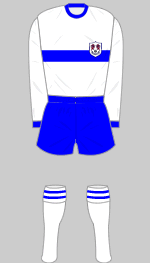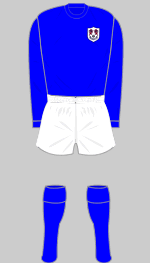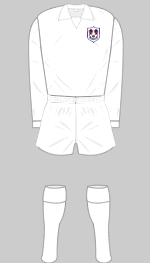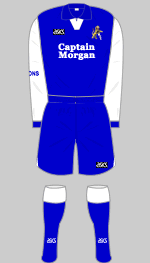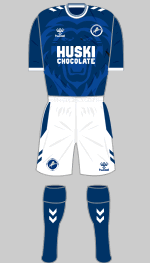Kit History
Millwall Rovers
1885
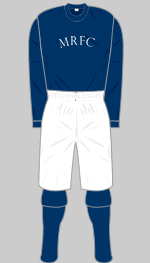
1885-1886 a c
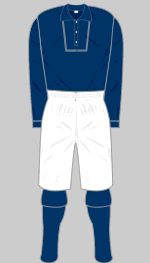
1887-1889 b c
Millwall Athletic
1889
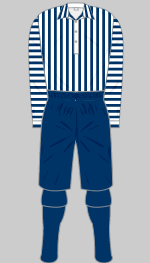
1889-1892 c
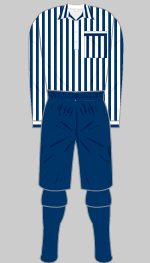
1892-1893 i c
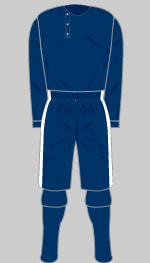
1893-1894 c r
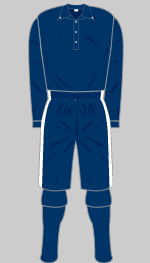
1894-1895 c
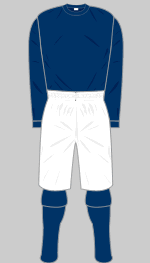
1895-1896 m n p
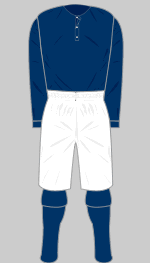
1896-1897 c
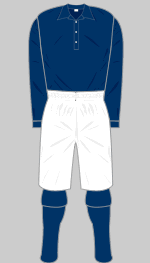
1899-1900 c
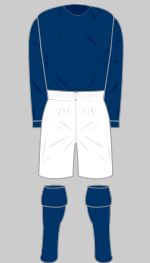
1900-1906 c
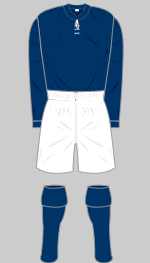
1907-1910 c
Millwall
1910
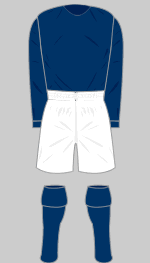
1910-1911 n
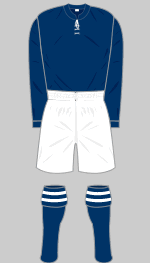
1911-1923 c
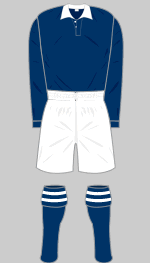
1923-1924 i

1924-1933 c
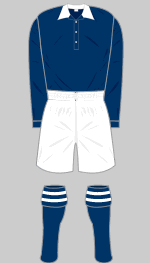
1933-1935 c f
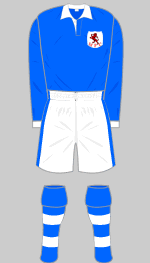
1936-1937 c i
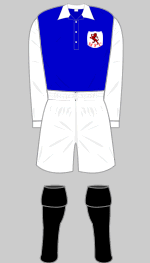
1945-1946 (1) i
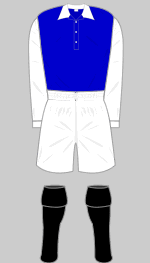
1945-1946 (2) c i
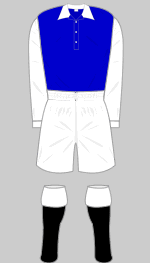
1945-1946 (3) i
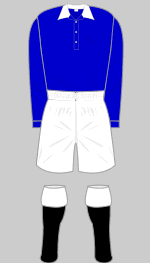
1945-1946 (4) i
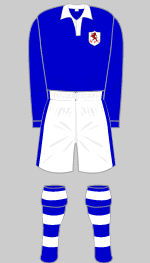
1950-1953 h
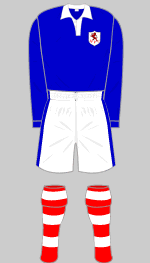
1953-1954 i
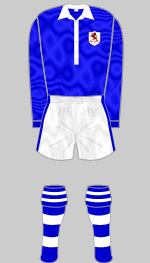
1954-1955 h i n
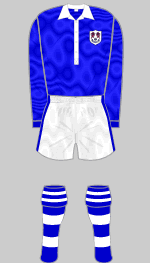
1955-1956 i
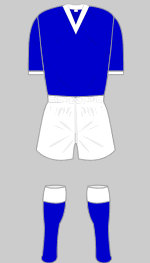
1959-1960 i
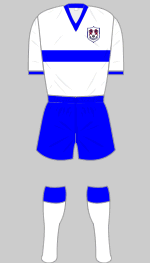
1960-1961 h
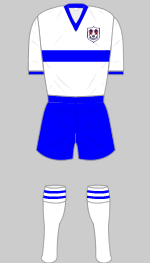
1961-1963 d h
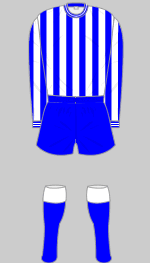
1964-1966 a h
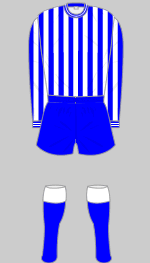
1966-1967 t
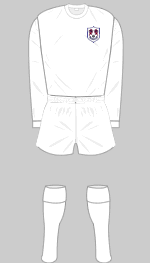
1968-1972 d h k
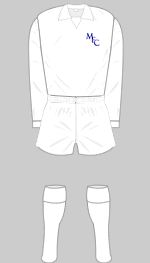
1972-1973 d h
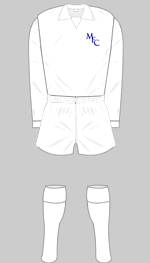
1974-1975 h
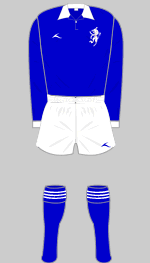
1975-1977 1 h i l
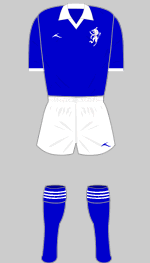
1975-1977 2 i
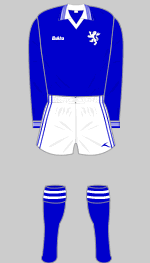
1977-1978 d h l
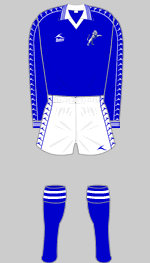
1978-1980 e h l
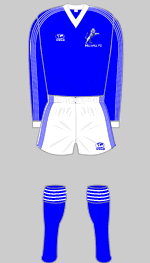
1980-1981 b h
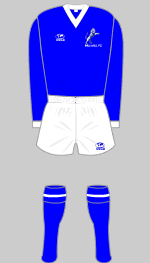
1981-1982 h
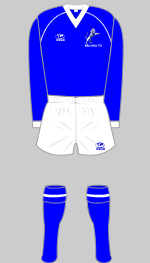
1982-1983 h
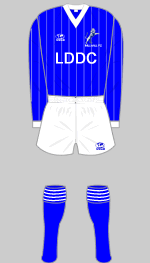
1983-1984 d h
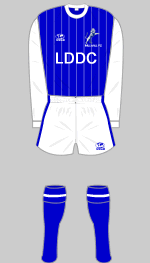
1984-1985 b h
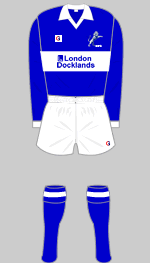
1985-1986 b h i
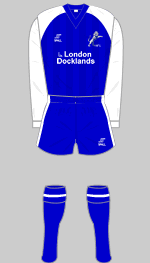
1986-1987 b h
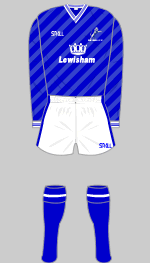
1987-1988 b h
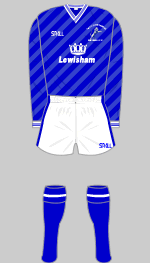
1988-1989 s
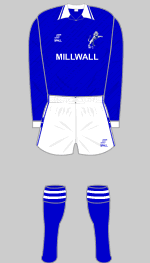
1989-1990 b h j
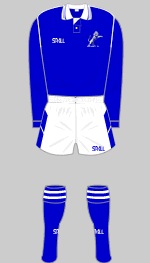
1990-1991 b h j q
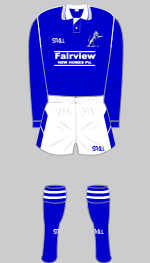
1991-1992 b h j
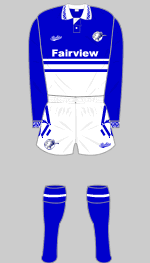
1992-1993 early b
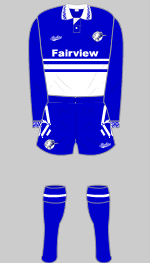
1992-1993 late b h j
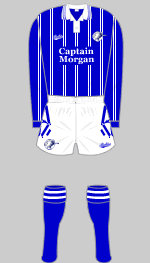
1993-1994 b h j
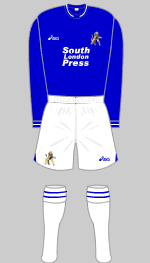
1996-1997 b h
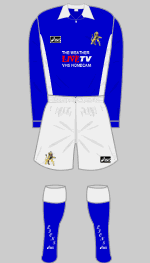
1997-1999 d h i
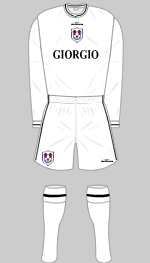
1999-2001 b h
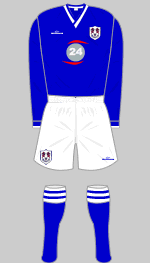
2001-2003 d
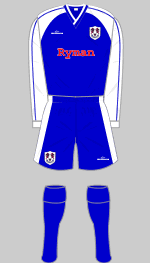
2003-2004 d j
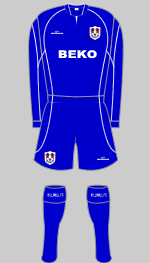
2004-2005 d j
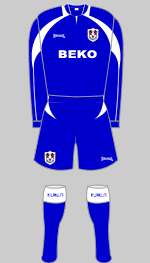
2005-2006 a
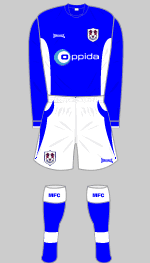
2006-2007 a
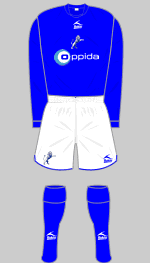
2007-2008 a
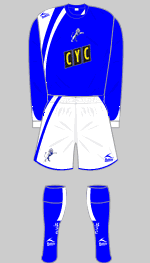
2008-2009 a
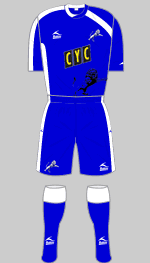
2009-2010 a
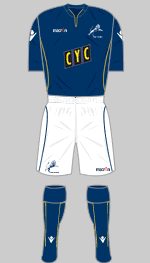
2010-2011 a
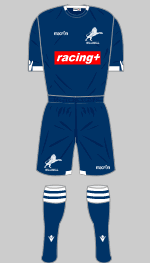
2011-2012 a
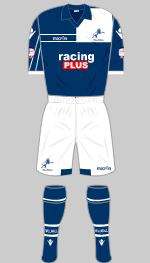
2012-2013 a
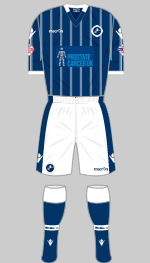
2013-2014 a
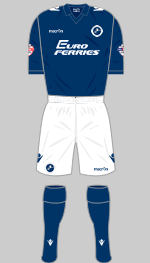
2014-2015 a
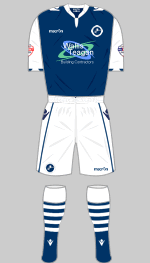
2015-2016 a
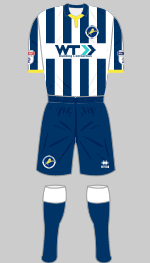
2016-2017 a
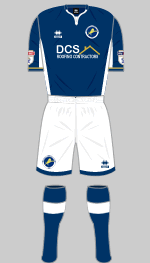
2017-2018 a
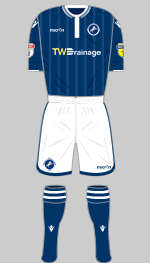
2018-2019 a
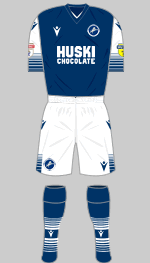
2019-2020 a
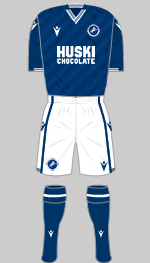
2020-2021 a
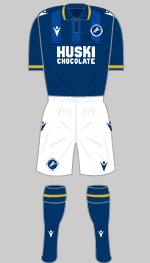
2021-2022 a
Background
 Millwall Rovers were originally
a works side, formed in the summer of 1885 by workers at Morton's Cannery on the Isle of Dogs, where various products were canned for export. Since most of the staff were emigre Scots,
the natural choice was to play in navy and white, with "MRFC" embroidered across the chest of their jerseys. As a humble works team it is hardly surprising that players wore a variety of mismatched tops over the next few seasons.
Millwall Rovers were originally
a works side, formed in the summer of 1885 by workers at Morton's Cannery on the Isle of Dogs, where various products were canned for export. Since most of the staff were emigre Scots,
the natural choice was to play in navy and white, with "MRFC" embroidered across the chest of their jerseys. As a humble works team it is hardly surprising that players wore a variety of mismatched tops over the next few seasons.
In April 1889 it was resolved to change the name of the club to Millwall Athletic ahead of the planned move to the Athletic Ground, which was completed the following June. Striped shirts were adopted and during this transitional season the press referred to the team as both Rovers and Athletic.
In 1893 Millwall Athletic turned
professional and joined the Southern League where they were to become a
leading side, reaching the FA Cup semi-finals in 1900 and 1903. They became known as "the Lions of the South" as a result, later shortened to "the Lions." The team wore a
distinctive all-navy kit with a white stripe sewn into their britches
until 1895. In 1910 the club, now known simply as Millwall, relocated
to The Den in New Cross, south of the Thames. In 1920, along with 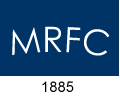 the
rest of the Southern League Division One clubs, Millwall became founder
the
rest of the Southern League Division One clubs, Millwall became founder
In 1928, "The Lions" were promoted to
Division Two and managed to consolidate until, following the death of
their manager, Bob Hunter, morale went to pieces and Millwall were relegated
in 1933. In 1936 the club dropped navy blue in favour of "royal blue" shirts
emblazoned with a red lion badge. Photographs suggest that the shirts worn in that first season were a rather lighter shade of blue than those used from 1938 on. 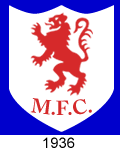 The new image seemed to do the trick."The
Lions" returned to Division Two in 1938 but their progress was cut
short when
The new image seemed to do the trick."The
Lions" returned to Division Two in 1938 but their progress was cut
short when 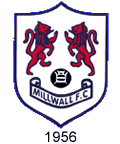 the League was suspended during World War Two.
the League was suspended during World War Two.
Millwall reached the 1944 southern region war time cup final against Chelsea. As Millwall had no change strip, a set of white shirts were borrowed from the FA and the pre-war crest was temporarily sewn over the three-lions badge. The badges were removed afterwards and later appeared on the early post-war shirts.
In 1948, Millwall
were relegated back into Division Three (South) and ten years later, when
the regional divisions were scrapped, the club found itself in Division
Four. The o riginal lion rampant badge was replaced in 1956 with the more familiar version with two lions. Fashionable shiny rayon shirts were worn between 1954 and 1956 when modern V neck shirts were adopted. The shiny shirts were, however, worn in floodlit
riginal lion rampant badge was replaced in 1956 with the more familiar version with two lions. Fashionable shiny rayon shirts were worn between 1954 and 1956 when modern V neck shirts were adopted. The shiny shirts were, however, worn in floodlit 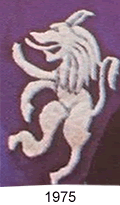 friendly matches until 1959 because it was thought they would show up better under the primitive lights of the period.
friendly matches until 1959 because it was thought they would show up better under the primitive lights of the period.
In the early Sixties Millwall battled their way back to Division Two, setting a record of 59 home League games without defeat in December 1966.
Between 1968 and 1975 the team wore all-white alternating between the two-lion crest and a simple "MFC" cypher.
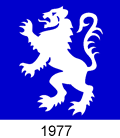 In 1972
the Lions narrowly missed out on promotion to Division One, finishing
in third place. Three years later they were back in traditional royal blue shirts, now emblazoned with a rather odd looking white lion rampant but dropped into Division Three. A more conventional version appeared on the new shirts that were introduced in 1977.
In 1972
the Lions narrowly missed out on promotion to Division One, finishing
in third place. Three years later they were back in traditional royal blue shirts, now emblazoned with a rather odd looking white lion rampant but dropped into Division Three. A more conventional version appeared on the new shirts that were introduced in 1977.
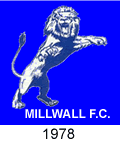 The lion rampant was replaced in 1978 with a leaping version, a motif that has proved as popular and enduring as the two-lion crest.
The lion rampant was replaced in 1978 with a leaping version, a motif that has proved as popular and enduring as the two-lion crest.
Fortunes
changed in 1985 when the club were promoted back into the Second Division.
 In 1988, Millwall won the Second Division championship to take their place
in the First Division for the first time. After a creditable 10th place
finish in 1989, it all went wrong and Millwall were relegated in 1990.
In 1988, Millwall won the Second Division championship to take their place
in the First Division for the first time. After a creditable 10th place
finish in 1989, it all went wrong and Millwall were relegated in 1990.
In May 1993 the club moved into a new 20,000 all
seater stadium at Senegal Fields, christened the New Den. With Mick McCarthy
in charge, Millwall were 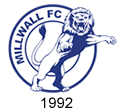 regularly challenging for promotion but the side
became unsettled when, in 1995, McCarthy left to manage the
regularly challenging for promotion but the side
became unsettled when, in 1995, McCarthy left to manage the 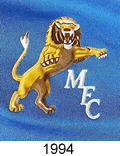 Republic of
Ireland. A year later Millwall were relegated to Nationwide Division Two
(the old Third Division). In January 1997 trading in Millwall's shares
was suspended and the club went into administration. A rescue package
was put in place and the club survived. During this period several versions of the leaping lion badge appeared before the older crest was reinstated in 1999.
Republic of
Ireland. A year later Millwall were relegated to Nationwide Division Two
(the old Third Division). In January 1997 trading in Millwall's shares
was suspended and the club went into administration. A rescue package
was put in place and the club survived. During this period several versions of the leaping lion badge appeared before the older crest was reinstated in 1999.
Four year later, in 2001, Millwall returned to
Nationwide Division One 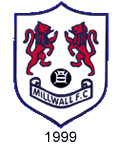 and narrowly missed out on promotion to the Premiership
the following season, losing out in the play-offs. In October 2003 Dennis
Wise and Ray Wilkins took charge and, after a remarkable run, Millwall
reached their first ever FA Cup Final in May 2004, losing 0-3 to Manchester
United at the Millennium Stadium. Once Wise and Wilkins moved on, success
and narrowly missed out on promotion to the Premiership
the following season, losing out in the play-offs. In October 2003 Dennis
Wise and Ray Wilkins took charge and, after a remarkable run, Millwall
reached their first ever FA Cup Final in May 2004, losing 0-3 to Manchester
United at the Millennium Stadium. Once Wise and Wilkins moved on, success 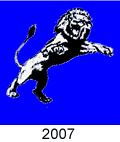 was hard to find and in 2006, the Lions were relegated from the Championship
to League One (once the Third Division). Perhaps in an attempt to improve their fortunes, the leaping lion returned the following season.
was hard to find and in 2006, the Lions were relegated from the Championship
to League One (once the Third Division). Perhaps in an attempt to improve their fortunes, the leaping lion returned the following season.
Millwall celebrated their 125th Anniversary in 2010 in the Championship after winning the play-off final the previous season. They also adopted a navy and white strip similar to their original from 1885, produced a limited edition version with the names of every player to have turned out for the club and a special crest.
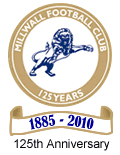 For the 2011-12 season Millwall retained the navy and white colours revived for the previous season
For the 2011-12 season Millwall retained the navy and white colours revived for the previous season 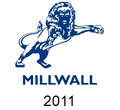 and introduced a slightly modified version of the leaping lion badge. In 2013 the club turned down shirt sponsorship by a payday loan company stating that such enterprises exploit those least able to afford their astronomical interest rates and instead donated the space to the Prostate Cancer charity. That same season a special crest was worn to mark the twentieth anniversary of the opening of the New Den. This design was retained the following season with suitably modified script.
and introduced a slightly modified version of the leaping lion badge. In 2013 the club turned down shirt sponsorship by a payday loan company stating that such enterprises exploit those least able to afford their astronomical interest rates and instead donated the space to the Prostate Cancer charity. That same season a special crest was worn to mark the twentieth anniversary of the opening of the New Den. This design was retained the following season with suitably modified script.
The team were relegated in 22nd place at the end of the 2014-15 season.
Stripes were reintroduced for 2016-17 to mark the 50th anniversary of their record 59 consecutive home 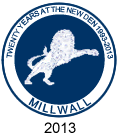 games without defeat. This proved a good omen as the team won through the play-offs to return to the second tier. The team's
games without defeat. This proved a good omen as the team won through the play-offs to return to the second tier. The team's 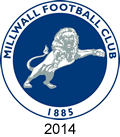 success was overshadowed by proposals by Lewisham Council to compulsorily purchase land around the Den owned by Millwall FC and sell it on to a shadowy offshore developer called Renewal. Confusion over funding arrangements, the involvement of former senior council officers and misleading accounts submitted by the charity set up to run the planned sporting facilities generated huge controversy. Under huge public pressure the council abandoned the Compulsory Purchase and, with a new Mayor in place, discussions resumed in January 2019 on revised plans that would engage the football club as a partner.
success was overshadowed by proposals by Lewisham Council to compulsorily purchase land around the Den owned by Millwall FC and sell it on to a shadowy offshore developer called Renewal. Confusion over funding arrangements, the involvement of former senior council officers and misleading accounts submitted by the charity set up to run the planned sporting facilities generated huge controversy. Under huge public pressure the council abandoned the Compulsory Purchase and, with a new Mayor in place, discussions resumed in January 2019 on revised plans that would engage the football club as a partner.
Sources
- (a) Millwall Official Website
- (b) Millwall Club History
- (c) Millwall FC 1885-1939 - Images of Sport (Chris Bethell, David Sullivan & Millwall FC Museum)
- (d) empics
- (e) Football Focus
- (f) The Football Encyclopaedia (Associated Sporting Press 1934) Information provided by Arthur Fergus
- (g) Pete's Picture Palace
- (h) Millwall FC 1940-2001 - Images of Sport (Millwall FC Museum)
- (i) Bill Bridges
- (j) David King
- (k) Football League Review provided by Simon Monks
- (l) Alick Milne
- (m) My photo library
- (n) Keith Ellis (HFK Research Associate)
- (o) Del
- (p) Richard Essen
- (q) Neil Andrews
- (r) Brian Webb
- (s) Alexander Leiberich
- (t) The Senior Tigers Club
- (u) Official club programme (16 March 1996) submitted by Stephen Mills
Modern crests are the property of Millwall FC.
